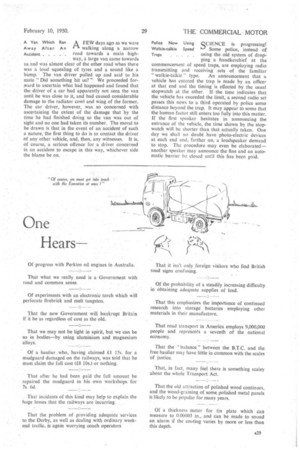way, a large van came towards us and was althost
Page 31

If you've noticed an error in this article please click here to report it so we can fix it.
clear of the other road when there was a loud squealing of tyres and a sound like a bump. The van driver pulled up and said to his mate "Did something hit us?" We proceeded forNvard to ascertain what had happened and found that the driver of a car had apparently not seen the van until he was close to it, and had caused considerable damage to the radiator cowl and wing of the former. The car driver, however, was so concerned with ascertaining the extent of the damage that by the time he had finished doing so the van was out of• sight and no one had taken its number. The moral to be drawn is that in the event of an accident of such a nature, the first thing to do is to contact the driver of any other vehicle, and, then, any witnesses. It is, of course, a serious offence for a driver concerned in an accident to escape in this way, whichever side the blame be on.
Police Now Using Walkie-talkie Speed Traps
qcIENCE is. progressing!
Some .police, instead of using the old system of dropping a handkerchief at the commencement of speed traps, are employing radio transmitting and receiving sets of the familiar " walkie-talkie " type. An announcement that a vehicle has entered the trap is made by an officer at that end and the timing is effected by the usual stopwatch at the other. If .the time indicates that the vehicle has exceeded the limit, a second radio set passes this news to a third operated by police some distance beyond the trap. It may appear to some that the human factor still enters too fully into this matter. If the first speaker hesitates in announcing the entrance of the vehicle, the time shown by the stopwatch will be shorter than that actually taken. One day we shall no doubt have photo-electric devices at each end and, farther on, a loudspeaker demand to stop. The procedure may even be elaborated— another speaker may announce the fine and an automatic barrier be closed until this has been paid.
Police Now Using Walkie-talkie Speed Traps




















































































